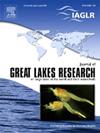Winter thermal structure across the Laurentian Great Lakes
IF 2.5
3区 环境科学与生态学
Q3 ENVIRONMENTAL SCIENCES
引用次数: 0
Abstract
The formation of winter stratification and thermal structure in general across the Great Lakes varies in character not just between lakes, but interannually within individual lakes. Three large datasets comprise all of the publicly available Great Lakes water temperature data that span both the winter and the entire water column. Multiple sites and multiple years of data are available for Lake Superior, as well as multiple years in Lake Huron and Lake Michigan, 2 years in Lake Ontario at multiple sites, and a single year at two sites in Lake Erie. The lakes show diverse manifestations of winter stratification, with Lake Superior reliably forming winter stratification, Lake Michigan rarely forming stratification, and Huron forming stratification in about half of the winters for which data are available (there is not enough data to evaluate this for Erie and Ontario). Whether a lake forms stratification or not in a given year is governed by how much heat a lake loses below the temperature of maximum density; a heat content of roughly −1 GJm−2 relative to the temperature of maximum density appears to be a threshold for the formation of winter stratification. Minimum heat content in a given year is a strong function of average winter air temperature. When combined with a historical database of basin-wide air temperature, the winter stratification threshold can be used to hindcast stratification formation in Superior, Huron, and Michigan over the last century, showing that Michigan and Huron are currently undergoing a climate-driven shift in stratification status.
横跨劳伦森五大湖的冬季热结构
整个五大湖冬季分层和热结构的形成不仅在湖泊之间,而且在个别湖泊内部也有年际变化。三个大型数据集包含了所有可公开获得的五大湖冬季和整个水柱的水温数据。苏必利尔湖有多个站点和多年的数据,休伦湖和密歇根湖有多年的数据,安大略湖有多个站点的2年数据,伊利湖有两个站点的单年数据。湖泊表现出不同的冬季分层表现,苏必利尔湖可靠地形成冬季分层,密歇根湖很少形成分层,休伦湖在大约一半有数据的冬季形成分层(伊利湖和安大略省没有足够的数据来评估这一点)。一个湖泊在某一年中是否形成分层取决于该湖泊在最大密度温度以下损失了多少热量;相对于最大密度温度约为- 1 GJm - 2的热含量似乎是冬季分层形成的阈值。某一年的最低热含量与冬季平均气温有很大关系。结合整个盆地的历史气温数据库,冬季分层阈值可以用来预测上个世纪苏必利尔州、休伦州和密歇根州的分层形成,表明密歇根州和休伦州目前正在经历气候驱动的分层状态转变。
本文章由计算机程序翻译,如有差异,请以英文原文为准。
求助全文
约1分钟内获得全文
求助全文
来源期刊

Journal of Great Lakes Research
生物-海洋与淡水生物学
CiteScore
5.10
自引率
13.60%
发文量
178
审稿时长
6 months
期刊介绍:
Published six times per year, the Journal of Great Lakes Research is multidisciplinary in its coverage, publishing manuscripts on a wide range of theoretical and applied topics in the natural science fields of biology, chemistry, physics, geology, as well as social sciences of the large lakes of the world and their watersheds. Large lakes generally are considered as those lakes which have a mean surface area of >500 km2 (see Herdendorf, C.E. 1982. Large lakes of the world. J. Great Lakes Res. 8:379-412, for examples), although smaller lakes may be considered, especially if they are very deep. We also welcome contributions on saline lakes and research on estuarine waters where the results have application to large lakes.
 求助内容:
求助内容: 应助结果提醒方式:
应助结果提醒方式:


